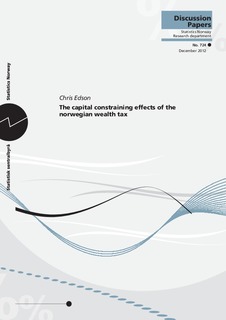| dc.contributor.author | Edson, Chris | |
| dc.coverage.spatial | Norway | nb_NO |
| dc.date.accessioned | 2019-11-13T07:44:31Z | |
| dc.date.available | 2019-11-13T07:44:31Z | |
| dc.date.issued | 2012-12 | |
| dc.identifier.issn | 0809-733X | |
| dc.identifier.uri | http://hdl.handle.net/11250/2628021 | |
| dc.description.abstract | This paper investigates if the Norwegian wealth tax imposes capital constraints on small privately held businesses. A panel of 31,428 Norwegian firms from 2005 to 2009 is used to estimate two models of capital constraints. The models are estimated using the Fixed Effects method. When firms are sorted a priori into two groups based on the wealth tax burden of the primary owner, the nontaxed firms are found to be slightly more constrained than the taxed firms, at a 10% and 5% confidence level depending on the model. Sorting based on the wealth tax is the most effective method of sorting firms into more or less constrained groups, while more traditional methods proved ineffective in this panel. The negative capital constraining effects of the wealth tax are therefore minimal; the tax affects only the private firms least reliant on internal financing | nb_NO |
| dc.description.sponsorship | Norwegian Research Council | nb_NO |
| dc.language.iso | eng | nb_NO |
| dc.publisher | Statistisk sentralbyrå | nb_NO |
| dc.relation.ispartofseries | Discussion papers;724 | |
| dc.subject | JEL classification: H23 | nb_NO |
| dc.subject | JEL classification: G3 | nb_NO |
| dc.title | The capital constraining effects of the norwegian wealth tax | nb_NO |
| dc.type | Working paper | nb_NO |
| dc.description.version | publishedVersion | nb_NO |
| dc.subject.nsi | VDP::Matematikk og Naturvitenskap: 400::Matematikk: 410::Statistikk: 412 | nb_NO |
| dc.source.pagenumber | 30 | nb_NO |
